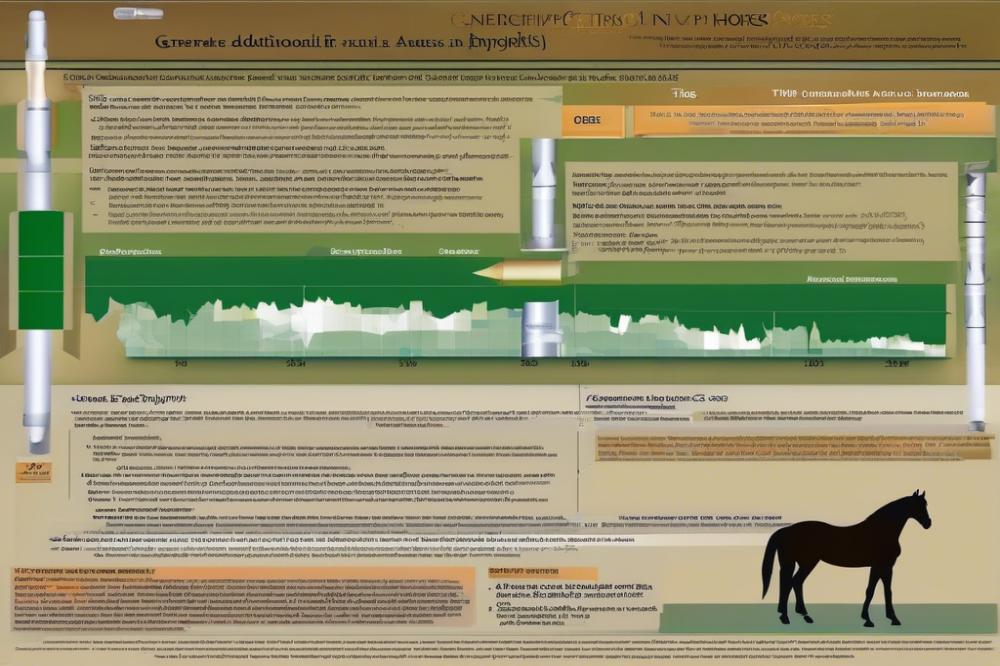Understanding Epiphysitis
Epiphysitis, in the world of horse care, is a term that might not yet roll off everyone’s tongue, but it certainly warrants attention. This condition involves inflammation of the growth plates in young horses. When talking about developing bones, the health of those growth plates is crucial. If a horse experiences epiphysitis, it can struggle with proper bone growth, leading to a multitude of equine issues.
The importance of addressing epiphysitis can’t be overstated. Just picture a growing horse, full of energy and potential, suddenly facing pain or difficulty moving. Not only does it affect their comfort, but it can also halt their progress in training and general activity. Understanding this condition is essential for ensuring that our four-legged friends lead healthy, vibrant lives.
In this article, we’ll dive into the ins and outs of epiphysitis in horses. We’ll explore its causes, symptoms, and the available treatments. Horse health is a complex puzzle, and epiphysitis is a piece of that puzzle for many horse owners. Beyond the technical aspects, we’ll also touch upon the experience of caring for different breeds of equine and how the right approach can help in managing these challenges.
Ever wondered how were horses trained for war? The care and attention to their health back then were crucial, just as they are today, especially when dealing with conditions like epiphysitis. Join us on this journey as we unravel this unique condition and discuss how to keep your horse feeling their best!
Understanding Epiphysitis

Explanation of the Condition
Epiphysitis is an important issue that affects the growth plates in young horses. It occurs when these growth plates become inflamed. This inflammation can lead to painful joints and a host of problems during a horse’s development. When we talk about inflammation, think of it like a sore spot. If a child bumps their knee, they have that tender feeling. Horses experience something similar in their joints when epiphysitis strikes.
Causes and Risk Factors
Many factors can contribute to this condition. Overfeeding can play a major role. If a horse gets too much nutrition too quickly, it can lead to rapid bone growth. This speedy growth often outpaces the surrounding soft tissues, causing discomfort. Additionally, genetics can be a factor. Some breeds, particularly large ones, are more prone to epiphysitis. Lastly, physical stress from exercise can also increase the risk. Think of it like running in shoes that are a size too small. It creates discomfort!
Types of Epiphysitis in Horses
There are a few types you should be aware of. Each type affects different areas of a horse’s body. For example, distal radial epiphysitis affects the front legs. This can lead to swelling near the knee. Another type is tarsal epiphysitis, which impacts the hock area. Both can cause limping and other equine health issues. As a horse owner, it’s crucial to pay attention to any signs of discomfort. If you notice your horse is limping or moving differently, don’t wait too long to seek help.
Keeping an eye on your horse’s bone growth and overall horse care can lead to better health outcomes. Every bit of knowledge on epiphysitis treatment goes a long way. Armed with the right information, you can help prevent this condition or at least catch it early. Remember, a healthy horse is a happy horse!
Symptoms and Diagnosis

Common Signs to Recognize
Noticing issues in your horse can feel like finding a needle in a haystack. Signs of epiphysitis might be subtle at first. Look for swelling around the joints, especially in younger horses. If your horse is limping or seems hesitant while moving, that’s a red flag. Increased heat in the affected areas could also be a concern. Observing your horse frequently can help you catch these early symptoms. If they seem more irritable than usual or don’t want to be groomed, something might be off.
Physical Examinations and Findings
When a vet steps in, they’ll start with a thorough physical exam. They’ll check the horse’s legs, looking for signs of swelling or tenderness. A basic range of motion test helps assess joint flexibility. Any discomfort during these checks may indicate an issue. After examining the visible signs, the vet will want to know about your horse’s history. Past injuries, changes in diet, or training routines can all point toward equine issues. Even their diet plays a role in bone growth and overall health!
Diagnostic Tests and Imaging Techniques
Sometimes, a simple examination isn’t enough to get the full picture. In these cases, your vet might recommend diagnostic tests like X-rays. Imaging can reveal bone abnormalities that aren’t visible to the eye. Ultrasounds might also come into play, especially to check soft tissues around the joints. Blood tests are another option to rule out infections or metabolic issues. A combination of these methods allows for a clearer diagnosis. When you address symptoms early, you can avoid more serious conditions down the road. Seeking timely epiphysitis treatment will ultimately benefit your horse’s health.
Treatment Options

Conservative Management Strategies
When dealing with epiphysitis, it often starts with a step back. Rest plays a big role in recovery. This means reducing the amount of exercise the horse gets. While it may seem boring, a little downtime can work wonders. Limiting their field time might help with those growing pains. Remember, young horses are full of energy, so finding ways to redirect that can be key. Hand-walking or guided light exercise can be good alternatives. This keeps them from getting too restless without putting too much strain on their developing bones.
Role of Anti-Inflammatory Medications
Flare-ups can be painful. That’s where anti-inflammatory medications shine. They reduce swelling and help with discomfort. Options like phenylbutazone are common in equine health strategies. Always consult with a vet to find what suits your horse best. Dosages can vary, and monitoring is an important process. After all, it’s about finding the right balance of pain relief without side effects. Medications work best when combined with proper horse care practices. Keeping a close eye on your horse’s response is essential.
Surgical Interventions if Necessary
Sometimes, despite all your best efforts, surgery might be the answer. When conservative methods don’t work, veterinarians can step in with more invasive solutions. The thought of surgery can be daunting, but it might improve horse health significantly. Surgeons can remove any excessive tissue or correct bone growth problems. These procedures aim to relieve pain and restore mobility. Just like any surgery, recovery is a journey. Post-surgery care includes managing pain and monitoring for any complications. Patience is key during this time as your horse heals.
Preventive Measures
Importance of Diet and Nutrition
Diet plays a vital role in the growth and health of horses. Without proper nutrition, young horses can face serious equine issues, like epiphysitis. Feeding them the right balance of nutrients turbocharges bone growth and sets the stage for a sturdy body.
Offering high-quality forage and grain is key. Make sure that hay is fresh and clean. Also, consider supplements that might help their growing bones. Always consult with a veterinarian or equine nutritionist. They can provide a tailored feeding plan. Remember, what goes into a horse literally affects how it grows!
Exercise and Training Recommendations
Exercise is another piece of the puzzle. Regular movement keeps bones and muscles strong. However, avoid pushing young horses too hard, as their bodies are still developing. Think of it like this: you wouldn’t run a marathon without training! Gentle, supervised workouts help them improve without causing strain.
Overtraining is a no-go, especially in young horses. Aim for consistency, not intensity. Mixing riding with turnout time helps keep them playful and fit. This combination promotes good horse health.
Regular Veterinary Check-ups
Don’t underestimate the impact of routine vet visits. Regular check-ups help catch potential issues before they snowball. Veterinarians aren’t just for emergencies; they can track your horse’s growth and catch any early signs of trouble. If you think about it, a little prevention goes a long way!
When you’re at the vet, ask about specific signs to watch for at home. Being proactive means being informed. Keeping in touch with your vet ensures that your horse stays happy and healthy.
Prognosis and Recovery
When dealing with epiphysitis in horses, the outcomes with treatment can be quite promising. Most horses respond well, especially if the condition is caught early. Owners often find that with the right care, many horses return to normal activity without long-lasting problems. Of course, the response to treatment can vary based on several factors.
Expected Outcomes with Treatment
A horse that receives proper epiphysitis treatment usually improves significantly. Many show signs of recovery within weeks. Imagine your horse prancing around, feeling like a million bucks, after overcoming a painful episode! But, it’s important to remember that not every horse will heal at the same pace. Some may need a bit more time and care to bounce back.
Factors Influencing Recovery Time
Several elements can impact recovery. The age of the horse plays a role; younger horses often recover faster due to more active bone growth. On the flip side, an older horse may take a little longer. Nutrition is another critical aspect. A balanced diet supports overall equine health and can speed up the healing process. Proper horse care, including rest and limited exercise, can also influence how quick the recovery is. Overworking a horse too soon may set them back, so patience is vital.
Long-Term Management Considerations
After recovery, a horse owner must focus on long-term care. Regular check-ups can help catch any future equine issues early. Monitoring the horse’s behavior and health is crucial. Pay attention to their movement, weight, and energy levels. Many find that a consistent exercise routine, tailored to their horse’s abilities, is beneficial. Keeping the weight in check is essential too. A well-managed horse is usually a happy one!
An owner may also want to speak with a veterinarian about dietary adjustments. Certain supplements could aid in proper bone growth and overall health. In summary, while the road to recovery might have bumps along the way, with the right strategies, many horses can lead full, active lives.
Wrapping it Up
In summary, understanding epiphysitis in horses is essential for anyone involved with equine care. This condition may sound complex, but it boils down to ensuring our horses stay healthy during their critical growth stages. Recognizing the signs and taking proper preventive measures can make a real difference in a horse’s life. Just like you wouldn’t want to run your car without oil, we need to take care of our young steeds before things go haywire.
Speaking of prevention, it’s vital to stay vigilant. Regular check-ups with a veterinarian, proper nutrition, and controlled exercise can help keep our four-legged friends on the right path. Horses, especially draft breeds, are prone to various health issues, so being proactive is key. Consider it similar to wearing a helmet while biking; it’s always better to be safe than sorry!
As we draw to a close, remember that caring for at-risk horses requires a little extra love and attention. Monitoring their growth, adjusting their diet as needed, and even utilizing techniques like horse ground tie can make a difference. Establishing a strong bond with your horse also plays a role in their health. Laugh together, go for a leisurely ride, and you might just notice when something feels off. In the end, it’s about creating a happy, healthy environment for our equine companions. Here’s to many happy and healthy rides ahead!



